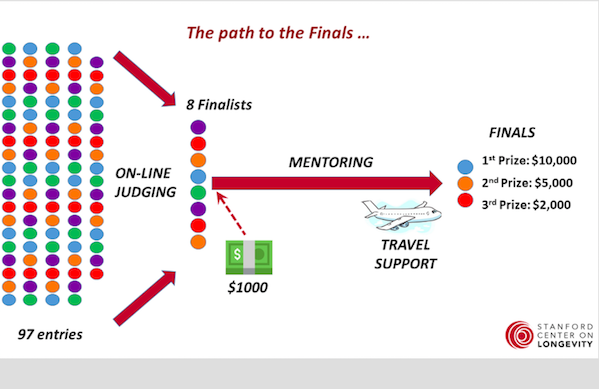When I was little, I loved sitting under the dining room table at family get–togethers. This was a front row seat to all of the best stories, and I delighted in listening to them. To this day, I can still hear my grandmother’s laugh as she listened to these stories.
Storytelling can be a powerful way to bring people together, and this was the very topic that caught the attention of judges at the Stanford Center on Longevity’s Design Challenge.
In a “design challenge”, contestants are asked to create a solution to a problem, obstacle or issue. For the past five years, the Davis Phinney Foundation has proudly sponsored this challenge for university students across the globe. The hope is to encourage the next generation of designers to consider products and services that improve well-being across the lifespan.
The theme this year—“Contributing at Every Age: Designing for Intergenerational Impact”—elicited many creative and innovative designs from 97 teams from 59 universities in 24 countries. From that pool, eight teams were selected to receive free entrepreneurial mentorship, paid travel expenses to Stanford University and the opportunity to pitch their concept to the judging panel.
After the teams pitched their designs to the audience and questions were answered, the judges (myself included!) retreated to a private room to discuss the merits of each design and decide on the winners. It quickly became clear that the two pitches revolving around intergenerational story-telling were favorites, and after much deliberation, we realized a consensus could not be reached on what team should take first place.
So, what do design challenge judges do when faced with an obstacle? We devised a solution: award TWO “first-place” winners!
The Winning Teams
First Place
“So You Think You Know Your Grandma” from UC Berkeley: A story-telling based card game designed to initiate intergenerational conversations.
“Family Room” from Stanford: An app to help families create and share the oral history of their older loved ones.
Third Place
“Pillow Fight” from YuanZe University in Taiwan: A simplified video game controller using a pillow that allows older adults and children to play an app-based video game together.
I was not only struck by the innovation and leadership displayed in these teams of budding designers, but also by the relevance of the winning designs to some of our work at the Foundation with Sidekicks. This intergenerational program aims to bring school-aged youth and people with Parkinson’s together to share stories and connect, which mirrors the storytelling focus of the two first-place designs.
As we live longer as a culture, and people are not as close geographically as they once were, intergenerational connections may become more difficult to make; however, through Sidekicks and programs from these winners, we may have found an avenue for people of all ages to live well!
Want to Support Similar Research Initiatives?
By making a donation to our research fund, you allow us to continue to work with innovators and experts in our field to identify specific and meaningful gaps in knowledge and care and produce new proven methods and tools for helping people live well with Parkinson’s. Support our Quality of Life Research Fund here.


